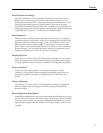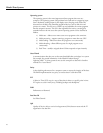
RAID
Redundant Array of Independent Disks. RAID is used to increase the reliability of disk
arrays by providing redundancy either through complete duplication of the data
(RAID-1, i.e., mirroring) or through construction of parity data for each data stripe in
the array (RAID-3, -4, -5). RAID-5, which distributes parity information across all
disks in an array, is among the most popular means of providing parity RAID since it
avoids the bottlenecks of a single parity disk. The Hitachi Freedom Storage
™
Lightning
9900
™
V Series algorithms enable performance from RAID-5 that is competitive with
some vendors’ RAID-1.
RAID Controllers
RAID controllers provide a highly optimized scheme for securely managing RAID
configurations on storage systems. Hitachi RAID controllers allow RAID arrays to be
expanded online and support conversion of an array from one RAID level to another.
Recovery Time
The period from the disaster declaration to the recovery of the critical functions.
Remote Copy
Remote Copy refers generically to software or hardware utilities that provide the
capability to copy data from one online volume to remote volumes without disruption.
Synchronous techniques are used for short distances (typically less than 25 miles), and
asynchronous techniques over LAN/WAN/MAN are used at any distance.
Remote Copy Links
This term refers to the links used between storage systems for the movement of data.
Today these links are either direct-connect ESCON
®
, Fibre Channel, or network links
(T3, ATM, etc). For direct-connect ESCON there is a limit of 43km (25 miles). For
direct-connect Fibre Channel the limit is 10km. However, newer technologies, such as
the Nortel
™
OPTERA
™
product, are allowing direct fibre connect over longer
distances.
Risk Management
The discipline that ensures that an organization does not assume an unacceptable level
of risk.
SAN
Storage area networks (SANs) connect storage systems to servers through Fibre
Channel or Ethernet switches. Hitachi's implementation of SAN is known as Hitachi
SAN
™
and falls under the larger Hitachi Freedom Data Networks
™
umbrella. Major
benefits of SANs include outboard backup, sharing of resources, pooling, and reduced
cost of storage management. SANs are high-speed subnetworks of shared storage
devices. SAN architecture works in a way that makes all storage devices available to all
servers on a LAN or WAN. Because stored data does not reside directly on any of a
network's servers, server power is utilized for business applications, and network
capacity is released to the end user. See also Fibre Channel.
71
Gl o s s a ry


















